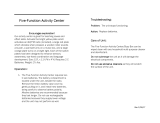
This section gives you important
information about how to protect
yourself and your passengers. It
shows you how to use seat belts
properly. It explains your Supple-
mental Restraint System. And it tells
you how to properly restrain infants
and children in your vehicle.
.........Important Safety Precautions . 6
.......Your Vehicle’s Safety Features . 7
.......................................Seat Belts . 8
...........................................Airbags . 9
.....................Seats & Seat-Backs . 10
..........................Head Restraints . 10
..................................Door Locks . 10
........Pre-Drive Safety Checklist . 11
............................Protecting Adults . 12
.....1. Close and Lock the Doors . 12
...........2. Adjust the Front Seats . 12
............3. Adjust the Seat-Backs . 13
...4. Adjust the Head Restraints . 14
5. Fasten and Position the Seat
.....................................Belts . 15
....6. Adjust the Steering Wheel . 18
7. Maintain a Proper Sitting
................................Position . 18
.....Advice for Pregnant Women . 19
...Additional Safety Precautions . 19
........................Protecting Children . 21
All Children Must Be
...............................Restrained . 21
Children Should Sit in the Back
...........................................Seat . 22
The Passenger’s Airbag Poses
......Serious Risks to Children . 23
If You Must Drive with Several
...................................Children . 25
If a Child Requires Close
..................................Attention . 25
...Additional Safety Precautions . 25
General Guidelines for Using
...............................Child Seats . 26
.......................Protecting Infants . 30
.........Protecting Small Children . 35
.......Protecting Larger Children . 38
Using Child Seats with
.....................................Tethers . 42
.............................Using LATCH . 44
Additional Information About Your
.................................Seat Belts . 46
..Seat Belt System Components . 46
......................Lap/Shoulder Belt . 46
Automatic Seat Belt
...............................Tensioners . 48
...............Seat Belt Maintenance . 49
Additional Information About Your
.....................................Airbags . 50
........................SRS Components . 50
How Your Front Airbags
.........................................Work . 50
...How Your Side Airbags Work . 52
How the SRS Indicator Light
.......................................Works . 53
How The Side Airbag Cutoff
...........Indicator Light Works . 54
.............................Airbag Service . 55
...Additional Safety Precautions . 55
.............Carbon Monoxide Hazard . 56
...................................Safety Labels . 57
Driver and Passenger Safety
Driver and Passenger Safety
5





















